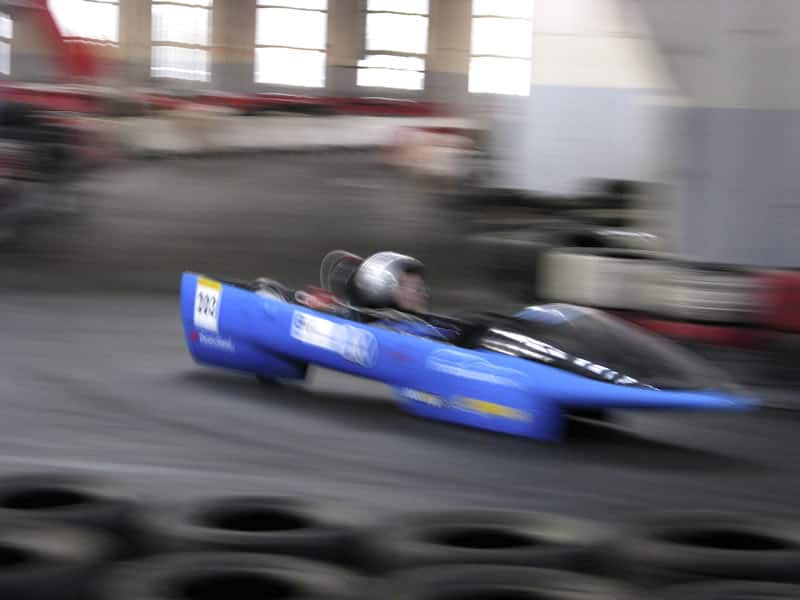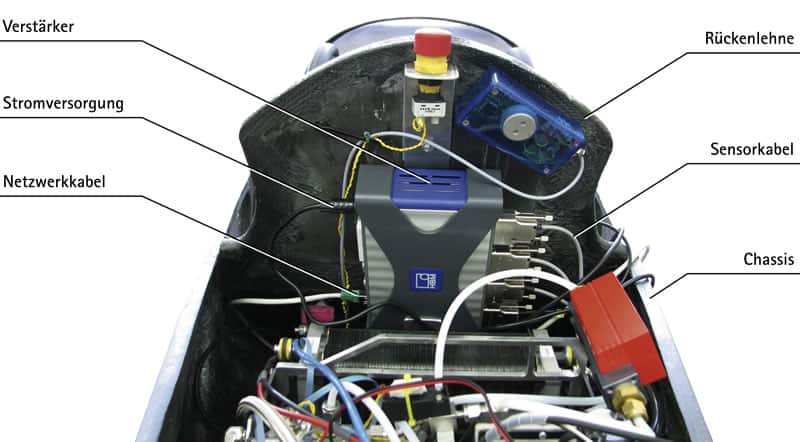100 km on 0.04 l – TU Chemnitz on the move and eco-friendly with QuantumX
The Fortis Saxonia Projects team, a student research project at the Chemnitz University of Technology (TU), is aiming to cover way over 2,500 kilometers with the Sax 3.1 during the 2009 Shell Eco-Marathon at the EuroSpeedway track in Lausitz. And for love of the environment, this is to be achieved powered only by a single liter of fuel. An impossible plan? Not with sophisticated technology and the support of HBM. Because QuantumX and state-of-the-art measurement technology from HBM can be relied on to supply the measurement data needed to optimize the fuel-cell driven three-wheel vehicle.
Innovative solutions to relieve the environment are even more in demand in times when energy and raw materials are scarce. For automobile manufacture, this means developing new vehicles in a lightweight construction with efficient and economical drive systems. Shell is one of those involved in sponsoring the development of this innovative mobility concept. The Eco-Marathon has been run since 1985, and is a competition that year after year, motivates students, academics and young engineers to construct even more efficient chariots. And their successes prove that ambitious designers are right. For example, in 2005, the first year it took part, Team Fortis Saxonia covered 655 km with Sax 1 powered by a single liter of fuel, whereas in 2008, with Sax 3, they were already covering a sensational 2,500 km.
Re-thinking mobility: Fortis Saxonia makes Sax 3 get a move on …
In 2009, the aim for the Fortis Saxonia Project is to be at the starting line for the Eco-Marathon at the EuroSpeedway in Lausitz with an improved version of the Sax 3 which to date, is the most efficient TU Chemnitz vehicle. A task that a team of around 20 students from various departments was happy to take on. The result is the Sax 3.1, a three-wheel vehicle weighing a mere 45 kg, which Team Saxonia hopes will build on last year’s impressive performance when it comes to this year’s Shell Eco-Marathon on May 7 to 9, 2009. The up-and-coming vehicle builders have put a correspondingly large amount of energy, know-how and high-tech into further improving their experimental vehicle, the Sax 3, to increase its range of 2,500 km by several hundred kilometers. So to further optimize the Sax 3, they logically had to have efficient measurement technology in the test and optimization phases.


… with QuantumX as co-pilot.
The extensive measurements that were needed to evaluate the driving performance of the new Sax 3.1 gave those involved in the project an additional problem: where to put all the measurement technology? Quite understandable, when you think that even the driver has to lie between the front wheels, as it is the only space available. HBM came up with the perfect solution – the compact QuantumX amplifier and strain gages, which ensure top-quality measured values, even in the smallest space.
All the mechanical quantities to be measured are acquired with electrical strain gages. The amplifier used was the QuantumX MX840. This has 8 channels for measurement acquisition and was mounted on the back of the driver’s seat. The power supply for the amplifier came from a 12 V battery with a capacity of 10 Ah. This was located in the vehicle nose area. This ensured that there would be a stable energy supply for the whole measurement run period. A laptop was loaded with version 2.24 of the catman Easy software to make the amplifier settings and to acquire and store the measurement data. During the test runs, this laptop was beneath the driver’s legs. At each “pit stop”, the measured values were checked and saved.
“The compact QuantumX was convincing all along the line”
“Just like our Sax 3.1, HBM’s QuantumX amplifier combines high-tech and high-performance in a compact format,” stressed Michael Klas, who is responsible for optimizing the front axle of the experimental vehicle for the project. “Our decision to opt for HBM measurement technology was the right one in every respect – not just because of the manageable dimensions of the amplifier, but more importantly, with regard to the very high quality of the measured values provided during the test runs.”
Incidentally: the use of the HBM technology brand for improving the experimental Sax 3.1 vehicle of the Fortis Saxonia project is just one of many examples in which measurement technology from Darmstadt has ensured greater energy efficiency and more considerate handling of valuable resources.